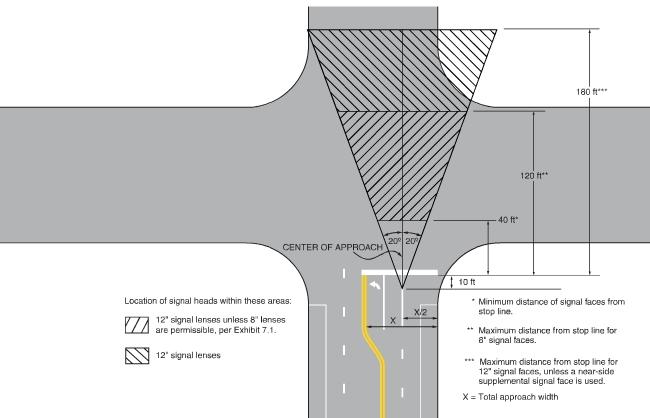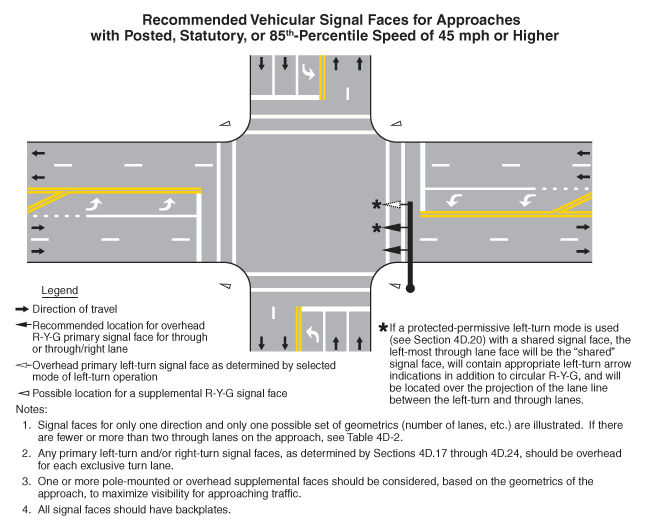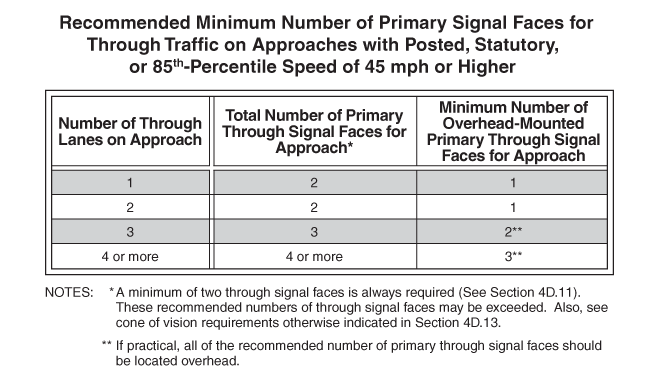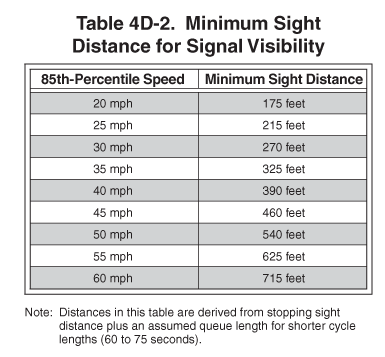Minimum Visibility Requirements

The MUTCD (Chapter 4D) requires that at least one signal face (but preferably both of the minimum of two primary signal faces required for the through movement, or the major turning movement if there is no through movement) be located within a cone of 20 degrees to the left or to the right of the "center of the approach lanes extended." The signal face that satisfies this requirement shall simultaneously satisfy the longitudinal placement requirement as shown in the figure. Primarily, signals should be located between 40 and 120 feet from the stop line. A signal may be located up to 150 feet from the stop bar if a near-side signal face is used. However, when larger signal faces are used (i.e., 12-inch in lieu of 8-inch), a signal can be installed up to 180 feet from the stop line without installation of a near-side supplemental signal face.
Nonetheless, where the nearest signal face is located between 150 and 180 feet beyond the stop line, engineering judgment of the conditions, including the worst-case visibility conditions, shall be used to determine if the provision of a supplemental near-side signal face would be beneficial.
In determining the required number of signal faces and the need for a near-side supplement signal face, refer to the MUTCD, as well as the local state's supplement to the MUTCD.

In all cases, the minimum number of signal heads for a primary approach is 2. If the posted or statutory speed limit or the 85th-percentile speed on an approach to a signalized location is 45 mph or higher, signal faces should be provided as follows for all new or reconstructed signal installations (see figure above):
- The minimum number and location of primary (non-supplemental) signal faces for through traffic should be provided in accordance with the table below.
- If the number of overhead primary signal faces for through traffic is equal to the number of through lanes on an approach, one overhead signal face should be located approximately over the center of each through lane.
- Except for shared left-turn and right-turn signal faces, any primary signal face for an exclusive turn lane should be located overhead approximately over the center of each exclusive turn lane.
- All primary signal faces should be located on the far side of the intersection.
- In addition to the primary signal faces, one or more supplemental pole-mounted or overhead signal faces should be considered to provide added visibility for approaching traffic that is traveling behind large vehicles.
- All signal faces should have backplates with a retroreflective yellow strip outlining the backplate.
This layout of signal faces should also be considered for any major urban or suburban arterial street with four or more lanes and for other approaches with speeds of less than 45 mph.

The two primary signal faces required as a minimum for each approach should be continuously visible to traffic approaching the traffic control signal, from a point at least the minimum sight distance provided in the table below in advance of and measured to the stop line. This range of continuous visibility should be provided unless precluded by a physical obstruction or unless another signalized location is within this range. If approaching traffic does not have a continuous view of at least two signal faces for the minimum sight distance shown, a Signal Ahead sign (W3-3) sign shall be installed to warn approaching traffic of the traffic control signal.



